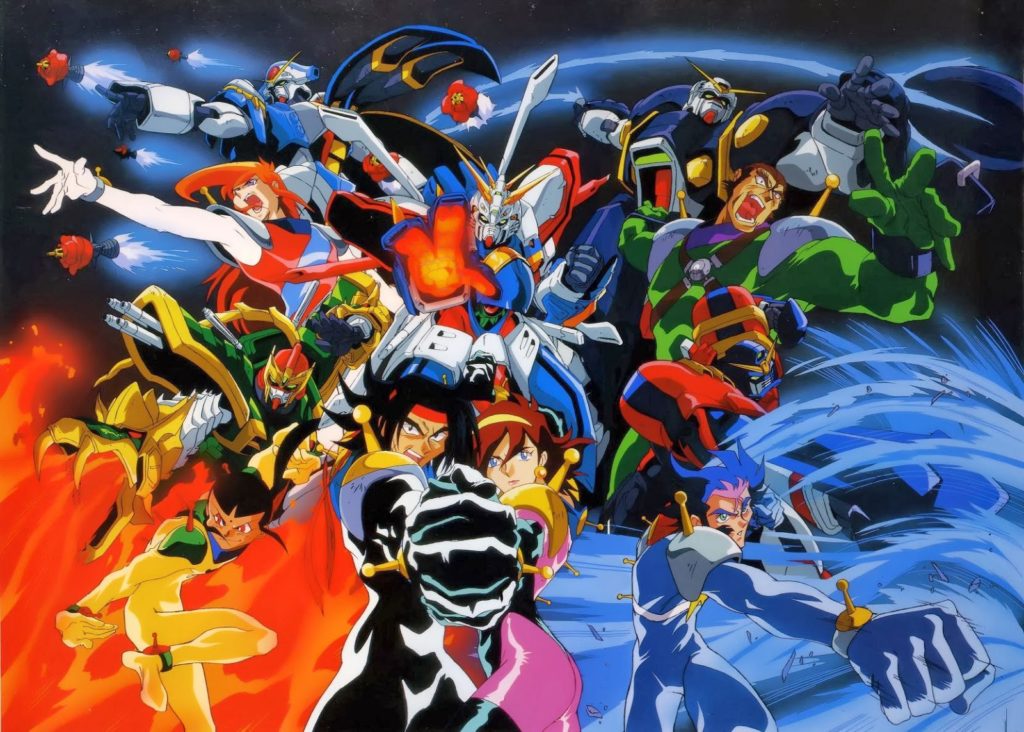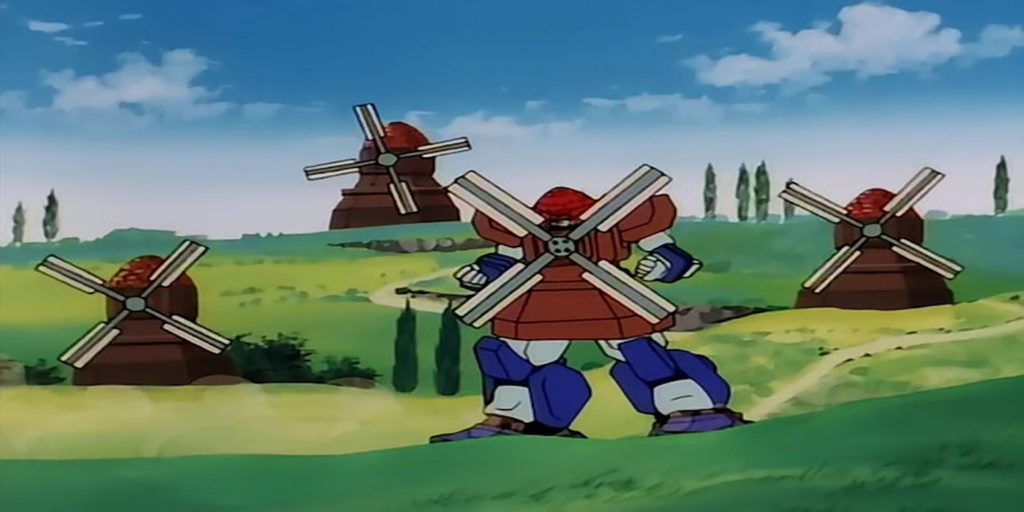G Gundam
September 20, 2023 · 1 comment
By Andrew Osmond.

For some fans, G Gundam is the series with a giant robot that looks like an American footballer, complete with shoulder pads. Or maybe it’s the show with the British Gundam (“John Bull Gundam”) that looks like a Beefeater, or the Canadian Gundam (“Lumber Gundam”) that wields twin axes. Or the Chinese Gundam that has fire-breathing dragons for arms, or the Mexican Gundam with cacti for arms…
You get the idea. If you think those sound silly, then I haven’t even got to the really deranged Gundams, many of which are held back to Volume 2.
As you may have gathered, Mobile Fighter G Gundam is not your average Gundam. Both detractors and defenders can argue it’s best not thought as a Gundam series at all, but rather a piece of mecha madness closer in spirit to Gurren Lagann or Promare, or to other pieces of preposterousness like JoJo’s Bizarre Adventure.

Officially at least, G Gundam began on TV in 1994, marking the fifteenth anniversary of the original Gundam in 1979. Up to then, all the Gundam anime had been set in the same timeline, called the “Universal Century.” G Gundam succeeded the 1991 video series Gundam: Stardust Memory and the 1993 TV series Victory Gundam, the latter directed by Gundam creator Yoshiyuki Tomino.
The new show was directed by Yasuhino Imagawa. However, he wasn’t the person who came up with G Gundam’s bonkers approach, as he explained in a presentation in America in 2002, written up on Animefringe. Imagawa had loved the original Gundam, with its more realistic drama, steering away from simple goodies and baddies towards the messiness and reciprocal cruelty of real war.
Born in 1961, Imagawa’s early credits included several Tomino titles. He storyboarded on episodes of Zeta Gundam and worked on other Tomino mecha shows, with more boarding on 1982’s Xabungle and multiple credits on the 1983 fantasy Aura Battler Dunbine, where he directed nine episodes. Imagawa also worked on very different anime, such as the ‘80s epic Pro Golfer Saru. However, Western fans are likelier to know him for his breakout director gig on a video series that started in 1992. It wasn’t a Tomino anime, but it was most certainly a mecha epic, called Giant Robo.

Brash, spectacular and proudly old-school, Giant Robo was a celebration of a vintage manga artist, Mitseru Yokoyama, with the anime featuring many of his strip characters. But it was more than that. The Anime Encyclopedia described Giant Robo as “the first of the 1990s retro boom… anime made in a deliberately old-fashioned style that recalls the imagery of the Golden Age of sci-fi and also reminds baby boomers of their carefree childhoods.” Giant Robo’s long production – the last video episode wasn’t released until 1997 – encompassed G Gundam; small wonder their sensibilities are close.
As Imagawa explains in the Animefringe piece, robot shows, whether silly or serious, have one prime business directive – to sell robot toys. However, the Gundam toys’ sales had dropped in recent years, and the sponsors wanted a show to reinvigorate the brand. Imagawa remembers his own initial designs were scrapped with barely a glance; instead he was presented with the designs that had to be in the anime, along the “national stereotype” lines described above.
Imagawa says he was shocked as many of Gundam’s long-standing fans were. Animefringe quotes him saying, “I was afraid of walking alone at night, since someone might stab me for doing this to Gundam.” He said he retaliated by deliberately designing some of the new Gundams in complicated ways so they couldn’t be recreated as toys… only they could be turned into toys, and were. At that point, Imagawa said, “I lost to the sponsor.”

G Gundam is the first Gundam without a “Universal Century” dateline, though the basic set-up has bits of the usual template. Once more, it’s a human conflict, with humans split between those on Earth and those in the stars. This time, though, Earth isn’t a ruthless authority; instead it’s largely in ruins, and its people are an underclass. The rich and successful have moved to space colonies (shades of Blade Runner); there are a great many different colonies, each modelled on one of the old Earth nations.
These colonies still have differences, but they’ve elected to solve them without war. Instead, once every four years, there’s a contest where the colonies send out a designated champion in a customised Gundam (as the big robots are called). The ultimate victor will then rule the other colonies until the next contest. Of course, the detail that this happens every four years suggests it’s essentially the Olympics – an event with special significance in Japan, since the Tokyo Olympics in 1964 symbolised Japan’s revival after World War II.
Of course, there’s more to the story. We follow Neo Japan’s candidate for the current contest, Domon Kesshu, whose Shining Gundam is decked out in the franchise’s traditional hero colours, blue, white and gold. But Kesshu is on a private mission too, looking for a man in a photo that he thrusts in the face of anyone he meets, asking if they’ve seen him. The backstory is revealed a few episodes in; it concerns the Devil Gundam, a mecha that could conquer all humanity.
Of course, it’s all proudly preposterous. As with Giant Robo, G Gundam is harking back to anime and manga from past decades, and especially to those robot shows that Gundam had supposedly supplanted, lurid, silly and magical. Even the name “Devil Gundam” would remind viewers of Devilman and his creator Go Nagai, who also devised many robot titans in the 1970s, starting with Mazinger Z. The same tradition is championed now by Hiroyuki Imaishi, director of Gurren Lagann and Promare. As mentioned above, G Gundam may be nearer to them than to most of the Gundam anime.
Except… This wasn’t the first time Gundam had scandalised fans by going silly. Eight years before, in 1986, Gundam’s creator Yoshiyuki Tomino started Gundam ZZ with huge dollops of daftness, putting his characters into ridiculous comedy situations as if to apologise for the death and darkness in his previous shows. It’s questionable if G Gundam was much more of a stretch.
In the event, though, Sunrise would tamp things down again after G Gundam. The next Gundam series would be none other than Gundam Wing in 1995, a far more traditional Gundam series and the first to be embraced by American fandom. Subsequent Gundams would follow Gundam Wing’s lead far more, leaving G Gundam as an outlier… which is one reasons its fans love it.
Andrew Osmond is the author of 100 Animated Feature Films. G Gundam is released in the UK by Anime Limited.
Eric sanders
January 5, 2024 4:38 pm
G gundam is my favorite anime ever snice i did not watch the second half of g gundam plus the last episode shinning gundam my favorite gundam and burning gundam because it was on cartoon network now what if netflix will do a live action gundam series and g gundam movie and i love it